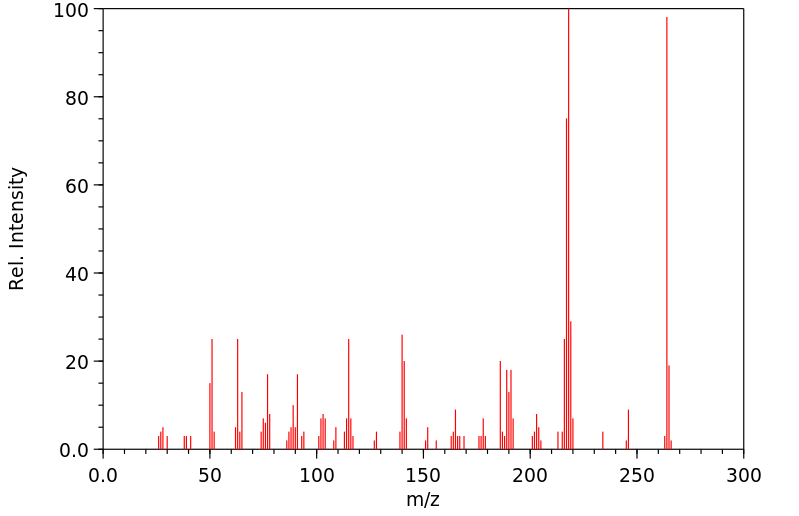1-(P-硝基苯基)-2-苯基-环丙烷甲腈 | 10432-22-1
中文名称
1-(P-硝基苯基)-2-苯基-环丙烷甲腈
中文别名
——
英文名称
cyano-1 p-nitrophenyl-1 phenyl-2 cyclopropane
英文别名
1-Cyano-1-(p-nitrophenyl)-2-phenyl-cyclopropan;1-p-Nitrophenyl-1-cyano-2-phenylcyclopropan;1-(p-Nitrophenyl)-2-phenyl-1-cyanocyclopropan;1-<4-Nitro-phenyl>-2-phenyl-cyclopropan-1-carbonitril;1-cyano-1-(4-nitro-phenyl)-2-phenyl-cyclopropane;Cyclopropanecarbonitrile, 1-(p-nitrophenyl)-2-phenyl-;1-(4-nitrophenyl)-2-phenylcyclopropane-1-carbonitrile
CAS
10432-22-1
化学式
C16H12N2O2
mdl
——
分子量
264.283
InChiKey
AVYTZYMHDAMJRD-UHFFFAOYSA-N
BEILSTEIN
——
EINECS
——
-
物化性质
-
计算性质
-
ADMET
-
安全信息
-
SDS
-
制备方法与用途
-
上下游信息
-
文献信息
-
表征谱图
-
同类化合物
-
相关功能分类
-
相关结构分类
计算性质
-
辛醇/水分配系数(LogP):3.1
-
重原子数:20
-
可旋转键数:2
-
环数:3.0
-
sp3杂化的碳原子比例:0.19
-
拓扑面积:69.6
-
氢给体数:0
-
氢受体数:3
安全信息
-
海关编码:2926909090
SDS
反应信息
-
作为反应物:描述:1-(P-硝基苯基)-2-苯基-环丙烷甲腈 在 sodium azide 、 三乙胺盐酸盐 作用下, 以 N,N-二甲基甲酰胺 为溶剂, 反应 4.0h, 以48%的产率得到4-azido-2-(4-nitrophenyl)-4-phenylbutyronitrile参考文献:名称:由磷腈作为催化剂和反应物实现的时间依赖性非对映发散迈克尔加成摘要:级联过程中步骤顺序的切换使得能够设计非对映发散方法来处理具有 1,3-立体中心关系的磷腈基吡咯啉。该方法基于易于获得的γ-叠氮丁腈的级联转化,包括 Staudinger、aza- Wittig和 Michael 步骤。立体发散是在迈克尔步骤实现的,由磷腈中间体自催化并提供四元立体中心的构建。根据磷腈中间体的类型,通过施陶丁格反应或通过随后的分子内氮杂-维蒂希与腈反应生成,然后与迈克尔受体反应,或者反式可以产生目标产物的- 或顺式异构体。因此,可以通过改变迈克尔受体的添加时间来实现非对映选择性。因此,磷腈在该过程中具有三个不同的作用:催化剂、反应物和立体选择性控制剂。这种立体发散策略被应用于生物相关四氢-7-氮杂-吲哚的所有立体异构体的合成。DOI:10.1002/adsc.202100570
-
作为产物:描述:参考文献:名称:Tinant, B.; Touillaux, R.; Declercq, J. P., Bulletin des Societes Chimiques Belges, 1983, vol. 92, # 2, p. 101 - 110摘要:DOI:
表征谱图
-
氢谱1HNMR
-
质谱MS
-
碳谱13CNMR
-
红外IR
-
拉曼Raman
-
峰位数据
-
峰位匹配
-
表征信息
同类化合物
(E,Z)-他莫昔芬N-β-D-葡糖醛酸
(E/Z)-他莫昔芬-d5
(4S,5R)-4,5-二苯基-1,2,3-恶噻唑烷-2,2-二氧化物-3-羧酸叔丁酯
(4S,4''S,5R,5''R)-2,2''-(1-甲基亚乙基)双[4,5-二氢-4,5-二苯基恶唑]
(4R,5S)-4,5-二苯基-1,2,3-恶噻唑烷-2,2-二氧化物-3-羧酸叔丁酯
(4R,4''R,5S,5''S)-2,2''-(1-甲基亚乙基)双[4,5-二氢-4,5-二苯基恶唑]
(1R,2R)-2-(二苯基膦基)-1,2-二苯基乙胺
鼓槌石斛素
黄子囊素
高黄绿酸
顺式白藜芦醇三甲醚
顺式白藜芦醇
顺式己烯雌酚
顺式-白藜芦醇3-O-beta-D-葡糖苷酸
顺式-桑皮苷A
顺式-曲札芪苷
顺式-二苯乙烯
顺式-beta-羟基他莫昔芬
顺式-a-羟基他莫昔芬
顺式-3,4',5-三甲氧基-3'-羟基二苯乙烯
顺式-1-(3-甲基-2-萘基)-2-(2-萘基)乙烯
顺式-1,2-双(三甲基硅氧基)-1,2-双(4-溴苯基)环丙烷
顺式-1,2-二苯基环丁烷
顺-均二苯乙烯硼酸二乙醇胺酯
顺-4-硝基二苯乙烯
顺-1-异丙基-2,3-二苯基氮丙啶
非洲李(PRUNUSAFRICANA)树皮提取物
阿非昔芬
阿里可拉唑
阿那曲唑二聚体
阿托伐他汀环氧四氢呋喃
阿托伐他汀环氧乙烷杂质
阿托伐他汀环(氟苯基)钠盐杂质
阿托伐他汀环(氟苯基)烯丙基酯
阿托伐他汀杂质D
阿托伐他汀杂质94
阿托伐他汀杂质7
阿托伐他汀杂质5
阿托伐他汀内酰胺钠盐杂质
阿托伐他汀中间体M4
阿奈库碘铵
锌(II)(苯甲醛)(四苯基卟啉)
银松素
铜酸盐(5-),[m-[2-[2-[1-[4-[2-[4-[[4-[[4-[2-[4-[4-[2-[2-(羧基-kO)苯基]二氮烯基-kN1]-4,5-二氢-3-甲基-5-(羰基-kO)-1H-吡唑-1-基]-2-硫代苯基]乙烯基]-3-硫代苯基]氨基]-6-(苯基氨基)-1,3,5-三嗪-2-基]氨基]-2-硫代苯基]乙烯基]-3-硫代
铒(III) 离子载体 I
铀,二(二苯基甲酮)四碘-
钾钠2,2'-[(E)-1,2-乙烯二基]二[5-({4-苯胺基-6-[(2-羟基乙基)氨基]-1,3,5-三嗪-2-基}氨基)苯磺酸酯](1:1:1)
钠{4-[氧代(苯基)乙酰基]苯基}甲烷磺酸酯
钠;[2-甲氧基-5-[2-(3,4,5-三甲氧基苯基)乙基]苯基]硫酸盐
钠4-氨基二苯乙烯-2-磺酸酯







